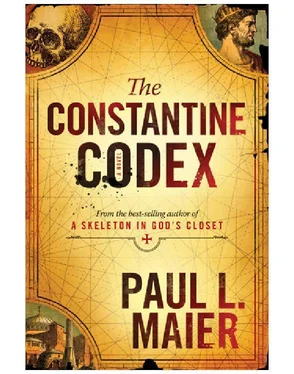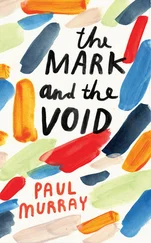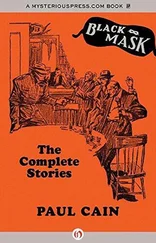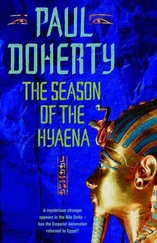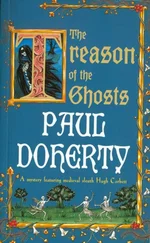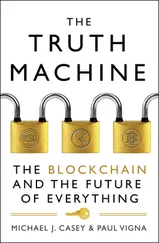Paul Maier - The Constantine Codex
Здесь есть возможность читать онлайн «Paul Maier - The Constantine Codex» весь текст электронной книги совершенно бесплатно (целиком полную версию без сокращений). В некоторых случаях можно слушать аудио, скачать через торрент в формате fb2 и присутствует краткое содержание. Жанр: Триллер, на английском языке. Описание произведения, (предисловие) а так же отзывы посетителей доступны на портале библиотеки ЛибКат.
- Название:The Constantine Codex
- Автор:
- Жанр:
- Год:неизвестен
- ISBN:нет данных
- Рейтинг книги:5 / 5. Голосов: 1
-
Избранное:Добавить в избранное
- Отзывы:
-
Ваша оценка:
- 100
- 1
- 2
- 3
- 4
- 5
The Constantine Codex: краткое содержание, описание и аннотация
Предлагаем к чтению аннотацию, описание, краткое содержание или предисловие (зависит от того, что написал сам автор книги «The Constantine Codex»). Если вы не нашли необходимую информацию о книге — напишите в комментариях, мы постараемся отыскать её.
The Constantine Codex — читать онлайн бесплатно полную книгу (весь текст) целиком
Ниже представлен текст книги, разбитый по страницам. Система сохранения места последней прочитанной страницы, позволяет с удобством читать онлайн бесплатно книгу «The Constantine Codex», без необходимости каждый раз заново искать на чём Вы остановились. Поставьте закладку, и сможете в любой момент перейти на страницу, на которой закончили чтение.
Интервал:
Закладка:
“Tell them about biblical manuscripts alone, Dick,” Jon said.
Richard Ferris was the general secretary for the Institute of Christian Origins, a lanky scholar whose crew cut seemed to remove a decade from his actual age. “Well, you all know the numbers and how our list of New Testament manuscripts has exploded across the years. For the King James translators in 1611, only six basic manuscripts were available, but by 1870, two thousand had been discovered for the Revised Version translators. Today, however, we have about 5,700 manuscripts in whole or in part. And of course, as we have to tell the public again and again, through textual research and criticism of all these manuscripts, we get more and more exact versions of what was originally written by the New Testament authors. That’s the good news.
“But the bad news Dr. Weber has already expressed. There are more manuscripts out there, and if we don’t find them in time, the world will have lost some priceless treasures. And it’s not just discovery. Some of these manuscripts have already been ‘discovered,’ as it were, but they’ve not been photographed, cataloged, or even examined. For example, Dr. Daniel Wallace, executive director of the Center for the Study of New Testament Manuscripts, recently sent a team to Albania to photograph ancient manuscripts in its national archive. They found no less than forty-five New Testament manuscripts that had never been photographed before-an incredible cache of documents in one of the least-likely places in the world! In fact, he estimates that maybe a thousand Greek New Testament manuscripts are still out there, yet to be discovered.” He paused to let the tidings mellow.
Heinz von Schwendener, New Testament professor at Yale, raised his pen and added, “And I’ll bet there could be more than a thousand in the long run. Okay, my colleagues, what’s our role in all this? How can the ICO contribute?”
“Glad you asked, Heinz,” Jon said. “In fact, I’m a little surprised that a Yalie is still awake to hear all this.”
“It’s only you Harvards that put me to sleep, Jon.”
Amid chuckling over the inevitable Harvard-Yale banter, Jon smiled and continued. “Here’s what I envision: an effort-hopefully an international effort-to search out every known library or archive of ancient manuscripts in the world and photograph all early un photographed biblical manuscripts contained therein. We’d then do further examination of the most ancient and important of those manuscripts as well.”
“Sounds like a task for several lifetimes, Jon,” said Sally Humiston of Berkeley’s archaeology department, “and requiring resources far beyond ours.”
“Exactly, Sal. I’ve been discussing this with the leadership at the Center for the Study of New Testament Manuscripts. They’d be delighted to cooperate with us in this endeavor, and we’ve sketched the following procedure.”
Jon switched on his PowerPoint presentation and directed his colleagues’ attention to the large screen behind him.
“First, we must reach a consensus on the most feasible modus operandi. This would determine the dos and don’ts in terms of searching out locations of libraries and archives with ancient biblical manuscripts, how to approach the respective authorities at each and secure permissions to photograph, and the like.
“Next, I recommend that we work up an overall comprehensive plan for the project, including the initial target collections. Then we would be ready to approach appropriate foundations for funding as well as recruiting scholars and photographic teams to do the job.”
“But haven’t many of the collections been microfilmed already?” Brendan Rutledge wanted to know. He was Princeton’s prime theologian.
“Yes, but many of them ought to be redone. Microfilming is really passe with our new technology. We’ll use digital photography instead, which is much better in every way. Here, check out the difference for yourselves.”
Jon passed out photocopies that showed two views of a leaf from the fourth-century Codex Vaticanus, one of the earliest uncial biblical manuscripts. To the left was a regular microfilmed version, and to the right a digital version. There simply was no comparison. In terms of clarity, ease of decipherment, even shadings in the lettering, the latter was far superior.
“Beyond that,” Jon continued, “at critical passages, we’ll also use multispectral imaging to check for text that’s faded, altered, or even erased. Manuscript copyists have been known to make mistakes.” A titter of laughter followed the last comment, since it seemed that nearly all ancient manuscripts had their share of errors, most of them quite minor.
A drone of discussion followed-not in challenge or objection, Jon was delighted to note, but in affirmation and enthusiasm. Suggestions and ideas rattled off the walls; scholar candidates were suggested, names of foundations offered.
At the close of the conference, Jon announced, “In order to practice what I preach, my wife Shannon and I want to participate in the project by targeting libraries and archives in Greece and Turkey-not all of them, obviously, but several that we think may be promising candidates. We plan to fly off just after the close of the spring semester.”
Those, of course, were the plans before the translation catastrophe struck. Now, it seemed their summer would be grotesquely transformed from the research and travel they had planned into a sickening scenario of looking behind themselves at potential danger-imagined or real-their lives hostage to the whim of some fanatic. Curse the translation error! Curse the fanaticism that could augment a tiny publishing miscue into world riots and bloodshed!
Some relief, however, came swiftly. The American and Canadian television networks had announced the error in translation earlier, and the BBC, Deutsche Welle, and the French, Italian, and Spanish networks soon followed. Jon and Shannon were greatly heartened when the ghastly riots on their TV were replaced by interviews with spokesmen for Islamic councils in the western European countries who announced that this had all been a mistake after all, that Professor Weber had apologized for it, and that the offending effigies and signs had now been removed.
“But I didn’t ‘apologize’ for it,” Jon objected. “I regretted it. There’s a difference.”
“Half a loaf is better than none, Jon,” Shannon reminded him.
Jon nodded slowly. “At this point I should be grateful for small favors. But why hasn’t Al Jazeera come clean on this? That’s the most-watched TV network in Muslim countries, so for their world, I’m still a blasphemous villain.”
But it was Al Jazeera that might rescue their summer after all-not intentionally, of course-and television rivalry seemed partially responsible. The Abu Dhabi television channel in the United Arab Emirates broke the news on the translation error to the Arab world, and Qatar Television immediately followed suit. Rather than be upstaged, Al Jazeera, perhaps in compensation for its late coverage, did an entire half-hour special on the typographical error in Jon’s book and how it had happened. They even had footage of the typesetter at his computer inside the editorial offices of the Cairo publisher, who blamed Osman al-Ghazali for the error, followed by footage of Osman in Cambridge blaming the typesetter. The program concluded with close-ups of the corrected text in the second printing of Jon’s book. Islam was now the greatest challenge to Christianity, not the greatest evil.
Sunni Muslims across the Islamic world-that broad band of latitude from Morocco to Indonesia-soon responded, almost with pride, at the corrected reading that showed their powerful counterpoise to Christianity. Still, Jon was hardly home free. The Shiites were silent. Although they represented only 16 percent of world Islam, it was the Shiite clergy in Iran who had placed the fatwa on his head. That fatwa had not been lifted.
Читать дальшеИнтервал:
Закладка:
Похожие книги на «The Constantine Codex»
Представляем Вашему вниманию похожие книги на «The Constantine Codex» списком для выбора. Мы отобрали схожую по названию и смыслу литературу в надежде предоставить читателям больше вариантов отыскать новые, интересные, ещё непрочитанные произведения.
Обсуждение, отзывы о книге «The Constantine Codex» и просто собственные мнения читателей. Оставьте ваши комментарии, напишите, что Вы думаете о произведении, его смысле или главных героях. Укажите что конкретно понравилось, а что нет, и почему Вы так считаете.
